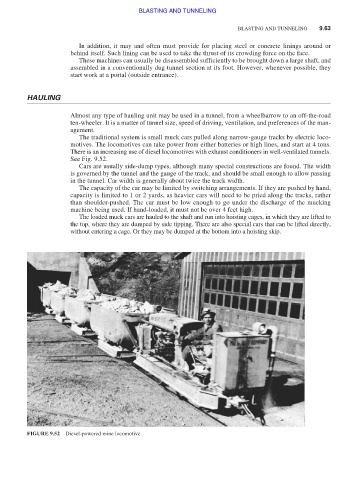Page 463 - Moving the Earth_ The Workbook of Excavation
P. 463
BLASTING AND TUNNELING
BLASTING AND TUNNELING 9.63
In addition, it may and often must provide for placing steel or concrete linings around or
behind itself. Such lining can be used to take the thrust of its crowding force on the face.
These machines can usually be disassembled sufficiently to be brought down a large shaft, and
assembled in a conventionally dug tunnel section at its foot. However, whenever possible, they
start work at a portal (outside entrance).
HAULING
Almost any type of hauling unit may be used in a tunnel, from a wheelbarrow to an off-the-road
ten-wheeler. It is a matter of tunnel size, speed of driving, ventilation, and preferences of the man-
agement.
The traditional system is small muck cars pulled along narrow-gauge tracks by electric loco-
motives. The locomotives can take power from either batteries or high lines, and start at 4 tons.
There is an increasing use of diesel locomotives with exhaust conditioners in well-ventilated tunnels.
See Fig. 9.52.
Cars are usually side-dump types, although many special constructions are found. The width
is governed by the tunnel and the gauge of the track, and should be small enough to allow passing
in the tunnel. Car width is generally about twice the track width.
The capacity of the car may be limited by switching arrangements. If they are pushed by hand,
capacity is limited to 1 or 2 yards, as heavier cars will need to be pried along the tracks, rather
than shoulder-pushed. The car must be low enough to go under the discharge of the mucking
machine being used. If hand-loaded, it must not be over 4 feet high.
The loaded muck cars are hauled to the shaft and run into hoisting cages, in which they are lifted to
the top, where they are dumped by side tipping. There are also special cars that can be lifted directly,
without entering a cage. Or they may be dumped at the bottom into a hoisting skip.
FIGURE 9.52 Diesel-powered mine locomotive.

